| Fri Jun 24, 2016 | Total posts : 1 |
|  Topic: Concrete Roof Insulation Topic: Concrete Roof Insulation
Hello all.
I am looking at different options for concrete roof insulation.
My house is under construction, so any change / amendment can easily be made at this stage.
There are 2 open to sky terraces on first floor ( 300 sq feet each ) , with rooms below them on Ground Floor. So I need to insulate the floors of these terraces to stop summers heat from entering the rooms below. Please note that at finishing stage I would be installing marble or porcelain tiles in these terraces.
Further, the top most roof of first floor is about 4,000 sq feet. I would like to insulate this as well, to save the rooms on first floor from direct heat of summers. Upon finishing here I would lay 4" to 5" compacted mud, and then brick-tiles over this.
My query is for both of the above said insulations, should I be using XPS ( Extruded Polystrene sheet ) or EPS ( Expanded Polystrene sheet ). For 2" thickness, my understanding is that both give same level of heat insulation. For water proofing I would be using bitumen + Polythene. So for heat insulation which product is better , less costly, with longer life ? Generally the EPS is cheaper than XPS, so is it worth to spend more for XPS ?
Please advise.
Thanks in advance
|
| |
| Sat Jun 25, 2016 | Post #1 | S L Gupta (Civil Engg)

Join date: Mar 2008 | Dear Omar
Thermal insulation is a method to reduce the transfer of heat from outside to inside. To make house heat proof,
thermal insulation is a good choice. An insulated home is more
comfortable as the temperature remains consistent over weather changes.
It makes the house comfortable and keeps the temperature of house cool in summers and warm in winters. It is very useful to keep the temperature of the house independent from outside temperature.
General Principles of Thermal Insulation
• Thermal resistance of an insulating material depends on the type of material and the thickness. • Provision of an air gap is very important and useful insulating agent. • Orientation of the building has important role in thermal resistance. • The
building/house design is done in such a way so that entry of solar
energy in summer should be minimum and in winter it should be maximum.
Choice of Insulating MaterialsChoice of insulating material depends on following considerations.
• Cost of insulating material.
• Area to be covered for insulation.
• Standard of insulation to be required.
• Cost of energy consumed for heating and cooling.
• Reasonable fire proof
• Non absorbent of moisture
• Not liable to undergo deformation
• Resistant to attack of small insects
Insulating Material1. Rock wool.
2. Slag slabs
3. Mineral wool slabs
4. Aluminum foils
5. Cement concrete block with lightweight aggregate.
6. Gypsum board
7. Asbestos cement board
8. Clip board
9. ACC cement board
10. Chip board
11. Foam glass
12. Gasket cork sheet, foam plastic etc.
How to apply insulating materialApply
CPRX compound of Shalimar Tar Products (STP) on ceiling of roof. For
fiberglass or glass wool insulation, you can fix 2" thick pieces. For
Thermocol or rubber foam, you can fix 2'X2' pieces. These can also be
fixed into wooden frames 2' X2' size. Finally, cover the treatment with
24 gauze perforated aluminum panel.
How Thermal Insulation is Beneficial• Comfort: The temperature of the room remains cool in summer and warm in winter
than that of outside atmosphere. Therefore, by providing thermal
insulation one feels comfort both in summer and winter season.
• Fuel saving:
Fuel is required to maintain desired temperature of the room. By
providing thermal insulation, the transfer of heat/cold reduces between
inside and outside of the room.. Hence, it saves fuel.
• Condensation Resistant:
Thermal insulation materials fixed on inside surface of the room walls
prevent condensation on interior walls and ceiling. Condensation is
deposition of moisture and takes place when warm air comes in contact of
surface having temperature below dew point.
Thermal Insulation of Exposed Walls
The heat and cold radiate through exposed walls of the house. There
are following methods of thermal insulation of exposed walls.
1. You may provide suitable thickness of wall.
2. You may provide Hallow wall or cavity wall.
3. You may fix Hardboards or ply board on wooden batten over the wall for creating air space.
4. You may fix Thermal insulating material sheet inside and outside exposed wall to reduce heat/cold transmission.
5. You may construct outer wall with thermal insulating material if you have frame structural building or non-load bearing walls.
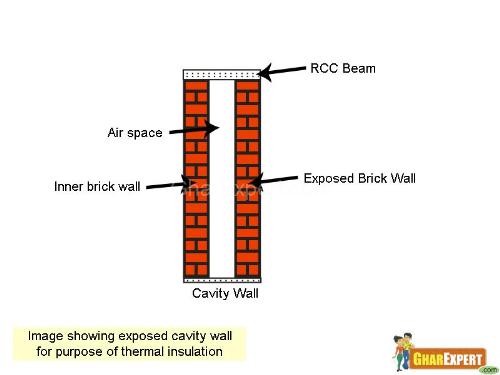
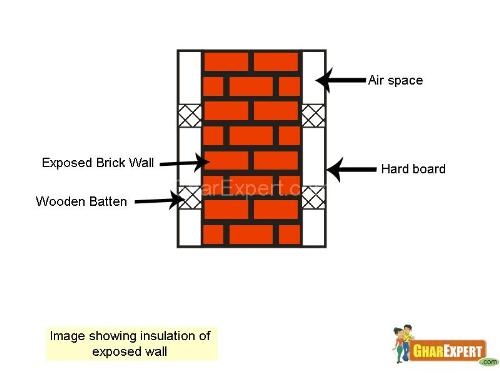
Thermal Insulation of Exposed Doors and Windows
Outside doors and windows transmit heat/cold through the room from
atmosphere. The methods providing thermal insulation are following.
1. The frames of doors and windows are of wood.
2. You should not use Iron or pressed steel frames as they transmit more heat and cold than that of wood.
3. You may fix Insulated glass in glazed doors and windows.
4. Double glass with air space provided on glazed door will reduce transmission of heat/cold from outside to inside.
5. You may provide sunshade projection on doors and windows to protect them from heat and rain.
6. You may use Curtains, ventilation blends etc. on exposed doors and windows.
Thermal Insulation of Exposed Roof
The roof of the one storey building or top roof of multi storey
building is an exposed roof. Heat/cold transmits through exposed roof in
the building. There are two types of treatment for thermal insulation
of exposed roof by providing treatment at the bottom or top of roof
slab.
a) Internal Treatment:
1. You can treat both types of slabs both types of slabs either flat roof or pitched roof.
2. You should provide Air gap for under exposed surface of roof by fixing false ceiling under the roof.
3. Ventilation abutting the roof also helps for passing the heat out of the room.
4. You should install false ceiling with thermal insulating materials.
5.
You may paste suitable adhesive and sealers at inside surface of the
exposed roof for fixing Light insulating materials. Some insulating
materials are glass wool, fiber glass wool, mineral wool, thermocol,
rubber foam etc.
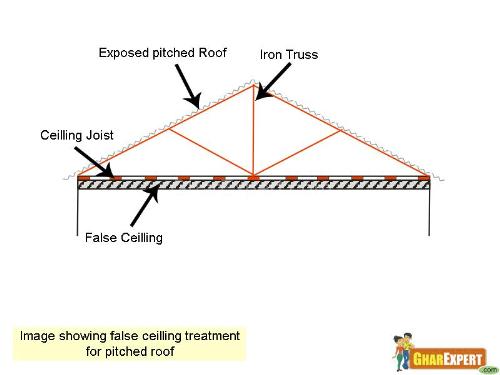
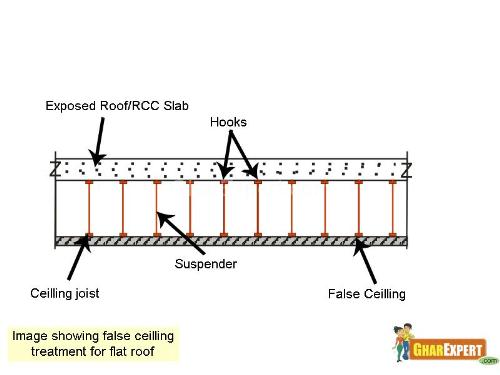
b) External Treatment:
Suitable shade may be provided on exposed top surface of the roof for reducing solar radiation.
2. Shining and heat reflecting coating may be applied on the top of exposed roof like paint.
3. These coatings can serve dual purpose of water proofing and heat reflection. 4. In case of flat roof you can create air space on top of roof by placing asbestos sheet on brick pillars. 5. The surface temperature of flat roof may be reduced by sprinkling water on roof at regular intervals during hot hours. 6. The surface of flat roof may be kept cool by storing water on roof. 7.
‘Mud Phuska’, which is a mixture of clay soil, wood shaving, and water,
should be laid on exposed roof acts as thermal insulation. 8. The
earth laid under tile terracing on top roof also serves the purpose of
thermal insulation and helps in giving proper shape for drainage of rain
water.
1.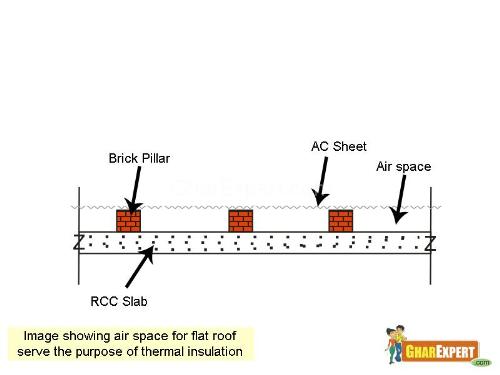
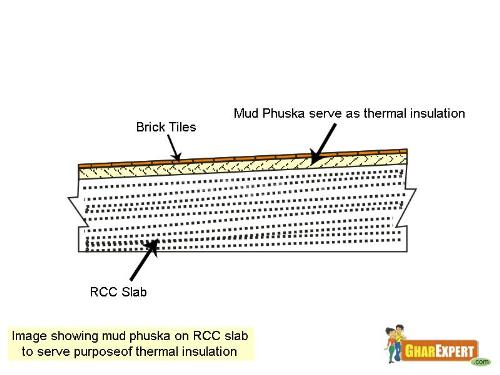
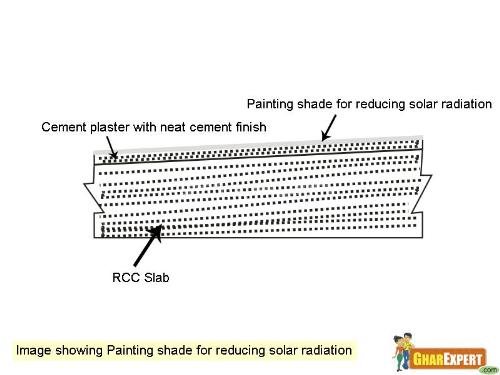
| | |
|
|
Green Building-Construction Questions (38) | |
|
|
|
| Articles that might interest you! | | Thermal Insulation of Home
No one likes to work in an uncomfortable environment where the temperature is either too hot or too cold. It is import.. | | Concrete Roofing- All time material
Concrete is an all time material for roofing. Simple flat roofs to sloped roofs, concrete roof tiles offered various s.. | | Types of Roofing
A solid roof on building is very important for everybody living in the house. The roof should be constructed in a way .. | | RCC Roofing
This roofing is very versatile and provides great protection. | | Flat Roof
Flat roof will be a better choice for which they want full use of building space. It appears flat with a slope for get.. | | Rubber Roofing- Eco Friendly Option
If you are looking for leak-proof roofing material, choose rubber roofing. Rubber roof is an eco-friendly, durable and.. | | Cooper Roofing- A Durable Option
The most beautiful Copper roof offers more durability and character than other metal roofs. Appearance of copper roofi.. | | Clay Roof Tiles
When it comes to tile roofing, clay roof tiles are the most admired roofing material. Appearance and durability of cla.. | | Tips for Laying RCC slab / roof
RCC slab laying is one of major step in any type of construction so it is mandatory to know all the points related to .. | | Roof Leaks - Causes and Repair
Are you worried about irritating roof leaks that destroy contents of the building and have adverse effects on the heal.. | | What are various types of glasses used in doors?
Types of glasses used in doors-Clear window glass, Plate glass, Prism glass, Quartz glass, Processed glass....... | | What are advantages and disadvantages of folding doors?
Advantages of folding doors- Easy to install,washable, durable, superior sound damping. Disadvantages-sensitive to har.. | | What are various designs available in wooden doors?
Designs available in Wooden doors..... | | What is standard size of internal folding doors?
Size, Thickness and Weight of Internal Folding Doors....... | | What affects the life of doors? What can we do to increase the life of the Wooden doors?
Tips to increase the life of Wooden doors.... | | What is the standard size of frame for Plastic/PVC doors?
Plastic Door frame size carrying one or two shutters...... | | What are various frames recommended for Plastic/PVC doors?
Frames for Plastic Doors.......... | | Which place is appropriate for sliding door?
Appropriate places for sliding doors-Bathrooms, Backyards, Commercial structures........... | | What are various frames recommended for glass doors?
Frames for Glass Doors-Wooden frames, Steel frames, Aluminium frames...... | | Which place is appropriate for folding doors?
Appropriate places for folding doors-Homes, Offices, Guest rooms, gives attaractive and stylish look........ | | What are the various accessories recommended for folding doors?
Accessories for folding doors- Door Handles, Door Fasteners,Door Viewers....... | | What affects the life of doors? What can we do to increase the life of the Plastic/PVC doors?
Tips to increase the life of Plastic doors.... |
|
|
|